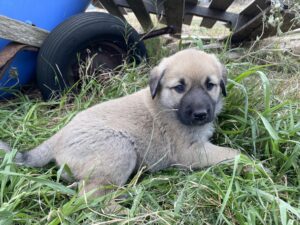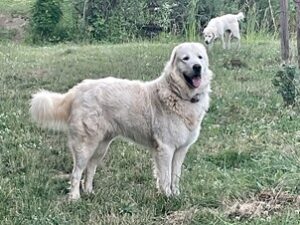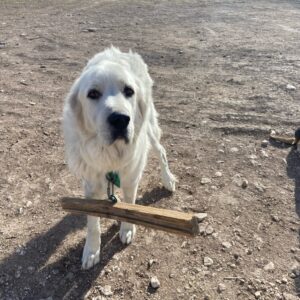Winter has arrived in Texas! Severe freezing weather and rain hit parts of the state last month, closing businesses and schools. More wet, wintry weather is expected this month. It is essential to make sure you are prepared for the weather and have shelter ready should you need it for your LGDs. All purebred LGD breeds have a double hair coat, and the long-haired dogs can withstand extreme temperatures. However, if your dogs are wet from heavy rains and exposed to below-freezing temperatures along with strong wind, the windchill can cause rapid hypothermia.
Your livestock and LGDs should have plenty of dry bedding and shelter from the wind to prevent a disaster from occurring if this situation occurs in your area. Make sure also to have an emergency kit for your dog should an emergency occur. We have a first-aid guide on our website that may be helpful. We keep most of it in an inexpensive tool bag. As always, check with your veterinarian beforehand to see what items are appropriate for an emergency kit.
AgriLife Livestock Guardian Dog Program: Update and Events
Our next online seminar will be on Feb. 15 at 3 p.m. The online workshop will be on the Maremma Breed and will be presented by long-time breeder Sarah Letts, owner of Sky Island Farm LLC in California. Letts is a past board president of the Maremma Sheep Dog Club of America and will discuss the distinct types of Maremma dogs and their characteristics in the online seminar. Check out the events page on our Facebook page for more information and to register for the event. You can also register for the online workshop on our website.
The Texas LGD Association (TLGDA) has added a Facebook Group Page so that producers can access help and information directly from the membership. Members can also post advertisements for pups and dogs directly instead of first submitting the information to board members. The group page is currently open to anyone interested in LGDs but will become a member-only resource in the future. The TLGDA website will soon be set up for member-only access. If you have not joined the association, now is the time to ensure you can access breeders and resources from the organization on Facebook, YouTube, and the website!
LGDs and Roaming – Part II
Devices to Control Roaming
LGD owners can use various methods to prevent their dogs from wandering off. One option is a dangle stick, which consists of a lightweight
wooden or metal pipe attached to a collar with a swivel and chain. When the dog runs, the stick bangs against its chest or legs, causing discomfort and making it difficult for the animal to move quickly. Another option is drags, which involve attaching a chain to a tire or log to slow the dog down. Portions of snowmobile tread and 55-gallon plastic chemical barrel sections also work well as drags for LGDs.
Other effective methods to control roaming include hotwire and invisible fencing. The multi-year AgriLife Bonding Project has assessed dogs bonded in hot wire pens vs. those bonded without hot wire pens. The study has shown that dogs bonded in hot wire pens as puppies roam less as adults than dogs not bonded in hot wire. We have evaluated two invisible fence systems and found that they work well to correct roaming behavior and change the dogs’ behavior for months. However, the battery life of both systems needs to be improved for large producers to use this technology.
Tethering can be a helpful corrective measure for roaming. Tethering should be done under the direct supervision of the handler to avoid injury or death. Tethering should only be used on adolescent dogs for short training periods and not to stop an adult dog from roaming. Laws in many states now regulate the tethering of dogs. Texas does provide an exemption to its tethering law for dogs used for agricultural purposes.
Kenneling dogs is another method that producers can use to correct roaming and other harmful behaviors in LGDs. Placing an LGD in a kennel with minimal human or livestock contact for three to four days may help correct unwanted behaviors. It is important to increase the kennel time by one day each time injurious behavior is noticed in the dog.
One of the most significant challenges of employing LGDs to safeguard livestock is their tendency to roam. To mitigate the issue, herders can be utilized, and roaming LGDs should not be bred and culled from the pack. Still, it is worth noting that certain types of LGDs are more prone to wander than others. Livestock producers should conduct thorough research on LGD breeds before acquiring a dog for their operation to reduce the likelihood of roaming.
Bonding Project Update
Round Five Dogs

Pearl is waiting to give us a muddy, wet greeting at the gate. AgriLife picture courtesy Costanzo, 2024
Overall, the puppies from this round are all doing great. We visited all the cooperating producers at the beginning of January and spoke with them about any concerns or issues with the pups. Belle was removed from her ranch in Uvalde and returned to the Center. She was rough playing with kid goats, and measures suggested to the producer to stop the rough play were not working. Belle will be placed with a producer in Comstock that has a large herd of mutton Angoras. Hopefully, once Belle fully matures at 18-20 months of age, she will be safe to place with young animals.
Maverick and Goose are still spending time together at the Center for several more weeks. They are bonding with the AgriLife Cedar Eating (ACE) goats that will be transferred to the Stephenville AgriLife Center in February.
Round Six Dogs
Puppies for round six will arrive in early February. We were lucky to get two sets of purebred dogs for this

Dasher is one of the Anatolian Shepherd pups in round six. AgriLife picture courtesy Dr. Gracia, 2024
round. We are purchasing three purebred Karakachan female pups and three Anatolian Shepherds for this project. This will be the final round of our research criteria that we started using in 2019. We will bond dogs to cattle in 2025 for a project to help protect swift foxes in the Rita Blanca National Grasslands. After that, we will continue bonding pups with sheep and goats. We will potentially acclimate LGDs to deer in 2026.
In closing
If you enjoyed this monthly LGD blog, please don’t forget to subscribe to it with this link: The Guardian Way | Texas A&M AgriLife Research and Extension Center at San Angelo.
To provide feedback on this article or request topics for future articles, please contact me at bill.costanzo@ag.tamu.edu or 325-657-7311.
The Texas A&M AgriLife Livestock Guardian Dog Program is a cooperative effort by Texas A&M AgriLife Research and the Texas Sheep and Goat Predator Management Board. Follow us on our social media sites and share them with your friends and family!
Facebook, Instagram, YouTube: @TAMUlivestockguarddog
 Do not forget to check out the Texas LGD Association online! Follow the organization on Facebook or YouTube at @TexasLGDAssociation, or check out the
Do not forget to check out the Texas LGD Association online! Follow the organization on Facebook or YouTube at @TexasLGDAssociation, or check out the






